Influence of Temperature and Moisture Content on Pavement Bearing Capacity with Improved Subgrade
Abstract
:1. Introduction
- The roughness of the pavement affects driving comfort;
- Skid resistance affects safe driving;
- Bearing capacity of the road pavement affects road pavement service life;
- Structural condition (cracking and patching) affects driving comfort in addition to aesthetic effects.
2. Main Characteristics of the Test Road
- Traffic monitoring;
- Temperature and moisture content at a different depths of the road PS;
- Roughness;
- Rutting;
- Longitudinal gradient and cross fall;
- Visual assessment of distress on the road PS;
- Road pavement deflection (measured with a FWD, Dynatest, Vinci, Italy and Benkelman Beam, Infratest, Brackenheim, Germany);
- Skid resistance (measured with a Pendulum device).
3. Test Plan and Methods
- The thickness of the asphalt concrete layer (measured by Georadar in 2015, Figures 4 and 5);
- The temperature on the top of the road PS (Table 1, Figure 6);
- The temperature at a different depth in the AC layers of the road PS (Table 1, Figure 6);
- Temperature and moisture content in the soil of subgrade at a different depth (Table 1, Figures 6 and 7);
- Surface modulus (E0, MPa) of the road PS (Figure 8);
- Periods (Table 2).
4. Statistical Analysis and Evaluation of Results
- The first part was descriptive and contained some statistical characteristics of the factors under study (mean, median, minimum and maximum values, standard deviation and quartile) in road PS (furthermore RPS) No 4, No 12, No 18 and No 24–25. The data was visualized in various layers in box-plot diagrams;
- In the second part, applying LMMs [28], it was attempted to assess whether the bearing capacity of the road PS has a statistically significant difference among sections and loaded and unloaded lanes (right and left wheel paths and tracks). The effect to the bearing capacity of the road PS of these factors was analyzed: the thickness of the AC layers, the temperature on the top of the AC surfacing and in the AC layer and the temperature and moisture content of the soil in the subgrade.
4.1. Descriptive Statistics
4.2. The Effect of the Thickness of the Asphalt Concrete Layers for the E0 and E0,h9
4.3. Fitting Linear Mixed Models (LMMs)
4.3.1. M1 Model for Dependent Variable E0,h9
4.3.2. M2 Model for Dependent Variable E0
5. Conclusions
- The possibilities of the LMM model allowed evaluating the dependence of the bearing capacity of the road PS on various fixed characteristics: the lane (unloaded or loaded) and their load mode, and these interactions, by finding specific random differences between points. These differences were not explained by the fixed characteristics included in the model. One of the reasons was that, even with the evaluation of fixed parameters, the bearing capacity of the road PS was different at points, there might be certain factors not included in the survey, i.e., structural characteristics of the section (cluster) or load size for each point at section (cluster). In this analysis, the load characteristic had only two values, i.e., loaded and unloaded. It was not known how much each point was loaded.
- Heavy vehicle loads affected the performance of road pavement and this effect was more significant (aggressive) in the trajectory of the path of the right wheels. Due to the lower bearing capacity of roadside up to 10% (the average E0 was 911 MPa at the right wheel path, and the average E0 was 984 MPa at the left wheel path) and ending of unbound base layer at the edge of asphalt and higher wheel stress asphalt wearing and binder layers rutted much more in right wheel path. Considering this, it was recommended for roads with ESAL’s of 1.0 mln and higher to prolong unbound base layer until slope of the roadside; this would increase structural strength of PS and decrease the depth of wheel stress.
- The usage of fine-grained sand 0/4 (the average E0 was 984 MPa) for the frost-blanket layer did not influence the PS bearing capacity and hydrothermal conditions, comparing with PS with the frost-blanket layer of sand 0/11 (the average E0 was 984 MPa). A difference of the bearing capacity was about 6%.
- Independently from asphalt layers overall thickness, E0 modulus average value in loaded or unloaded traffic lane changed slightly on average 5% (on average 932–976 MPa of the loaded lane and 990–1034 MPa of the unloaded lane). However, comparing the E0 modulus average values of loaded and unloaded traffic lanes, this tendency was not valid (the difference was up to 15%, 967 MPa of loaded lane and 1108 MPa of the unloaded lane). This way it was concluded that total traffic loads had a significant impact to the E modulus of PS.
- The most significant influence for pavement structural strength had the bearing capacity of the subgrade, susceptibility to hydrothermal impact, the thickness of asphalt layers and thickness of the whole PS. The unbound and bound layers only slightly influenced pavement structural strength.
- Analysis of overall E0 and E0,h9 data declared that seasonal impact on pavement structural strength due to a change of subgrade bearing capacity remained after correction of asphalt stiffness dependent on layer temperature. This assigned that stiffer asphalt layers in autumn and springtime were insufficient to compensate for the decrease of pavement structural strength due to decreased bearing capacity of subgrade. The bearing capacity during measuring autumn and spring periods of loaded lane changed respectively up to 6.3% (in autumn) and up to 8.3% (in spring; in PS No 4), up to 4.9% and up to 8.7% (No 12), up to 0.8% and up to 2.1% (No 18) and up to 1.9% and up to 5.3% (No 24–25). The temperature of asphalt pavement surface was on average about 14–18 °C (in autumn) and 3–10 °C (in spring). The bearing capacity results of the summer measurement (when temperature of asphalt pavement surface was on average about 20–31 °C) were one average up to 12.5% lower than in autumn and up to 6.1% lower than in spring.
- A subgrade improvement with the aggregates mix reaching deformation modulus EV2 higher than 100 MPa did not ensure the complete elimination of seasonal impact. Due to this, it was recommended for roads with ESAL’s of 3.0 mln and higher to use subgrade stabilization and for roads with ESAL’s of lower than 3.0 mln to use subgrade improvement or stabilization.
- It was detected that neither E0 nor E0,h9 were related to moisture content at a depths of 100 cm, 130 cm and 150 cm.
- This analysis was an initial step towards more detailed testing of road PS in the Test Road, it found some of the characteristics of the road PS and allowed for the adoption of appropriate engineering solutions.
Author Contributions
Funding
Conflicts of Interest
References
- Fonod, A. Degradation of the bearing capacity of asphalt pavements. Slovak J. Civ. Eng. 2005, 2, 35–39. [Google Scholar]
- Amorim, S.I.R.; Pais, J.C.; Vale, A.C.; Minhoto, M.J.C. A model for equivalent axle load factors. Int. J. Pavement Eng. 2015, 16, 1, 881–893. [Google Scholar] [CrossRef]
- Straube, E.; Jansen, D. Temperature correction of falling-weight-deflectometer measurements. In Proceedings of the 8th International Conference Bearing Capacity of Roads, Railways and Airfields, Two Volume Set (BCR2A’09), Champaign, IL, USA, 29 June–2 July 2009; Tutumluer, E., Al-Qadi, I.L., Eds.; CRC: London, UK, 2009; pp. 789–798. [Google Scholar]
- Salour, F. Moisture Influence on Structural Behaviour of Pavements: Field and Laboratory Investigations. Ph.D Thesis, KTH Royal Institute of Technology, Stockholm, Sweden, 2015. [Google Scholar]
- Hermansson, Å. Simulation model for calculating pavement temperatures including maximum temperature. Transp. Res. Rec. J. Transp. Res. Board 2000, 1699, 134–141. [Google Scholar] [CrossRef]
- Alawi, M.H.; Helal, M.M. A mathematical model for the distribution of heat through pavement layers in Makkah roads. J. King Saud Univ. Eng. Sci. 2014, 26, 41–48. [Google Scholar] [CrossRef]
- Motiejūnas, A.; Paliukaitė, M.; Vaitkus, A.; Čygas, D.; Laurinavičius, A. Research on the Dependence of Asphalt Pavement Stiffness upon the Temperature of Pavement Layers. Baltic J. Road Bridge Eng. 2010, 5, 50–54. [Google Scholar] [CrossRef]
- García, J.A.R.; Castro, M. Analysis of the temperature influence on flexible pavement deflection. Constr. Build. Mater. 2011, 25, 3530–3539. [Google Scholar] [CrossRef]
- Zheng, Y.; Zhang, P.; Liu, H. Correlation between pavement temperature and deflection basin form factors of asphalt pavement. Int. J. Pavement Eng. 2019, 20, 874–883. [Google Scholar] [CrossRef]
- Hermansson, Å.; Charlier, R.; Collin, F.; Erlingsson, S.; Laloui, L.; Sršen, M. Heat transfer in soils. In Water in Road Structures; Springer: Dordrecht, The Netherlands, 2009; pp. 69–79. [Google Scholar] [CrossRef]
- Bobes-Jesus, V.; Pascual-Muñoz, P.; Castro-Fresno, D.; Rodriguez-Hernandez, J. Asphalt solar collectors: A literature review. Appl. Energy 2013, 102, 962–970. [Google Scholar] [CrossRef]
- Javilla, B.; Mo, L.; Hao, F.; Shu, B.; Wu, S. Significance of initial rutting in prediction of rutting development and characterization of asphalt mixtures. Constr. Build. Mater. 2017, 153, 157–164. [Google Scholar] [CrossRef]
- Korkiala-Tanttu, L.; Dawson, A. Relating full-scale pavement rutting to laboratory permanent deformation testing. Int. J. Pavement Eng. 2007, 8, 19–28. [Google Scholar] [CrossRef]
- Wiman, L.G. Accelerated Load Testing of Pavements: HVS-NORDIC Tests at VTI Sweden 2003–2004. VTI Rapport 544A. 2006. Available online: http://www.diva-portal.org/smash/get/diva2:670625/FULLTEXT01.pdf (accessed on 8 April 2019).
- Qiao, Y.; Dawson, A.; Huvstig, A.; Korkiala-Tanttu, L. Calculating rutting of some thin flexible pavements from repeated load triaxial test data. Int. J. Pavement Eng. 2015, 16, 467–476. [Google Scholar] [CrossRef]
- Birgisson, B.; Ruth, B. Improving performance through consideration of terrain conditions: Soils, drainage, and climate. Transp. Res. Rec. J. Transp. Res. Board 2003, 1819, 369–377. [Google Scholar] [CrossRef]
- Charlier, R.; Hornych, P.; Sršen, M.; Hermansson, Å.; Bjarnason, G.; Erlingsson, S.; Pavšič, P. Water influence on bearing capacity and pavement performance: Field observations. In Water in Road Structures; Springer: Dordrecht, The Netherlands, 2009; pp. 175–192. [Google Scholar] [CrossRef]
- Dawson, A.; Kringos, N.; Scarpas, T.; Pavšič, P. Water in the pavement surfacing. In Water in Road Structures; Springer: Dordrecht, The Netherlands, 2009; pp. 81–105. [Google Scholar] [CrossRef]
- Hall, K.T.; Crovetti, J.A. Effects of Subsurface Drainage on Pavement Performance: Analysis of the SPS-1 and SPS-2 Field Sections. Trans. Res. Board 2007, 583, 190. [Google Scholar] [CrossRef]
- Charlier, R.; Laloui, L.; Brenčič, M.; Erlingsson, S.; Hansson, K.; Hornych, P. Modelling coupled mechanics, moisture and heat in pavement structures. In Water in Road Structures; Springer: Dordrecht, The Netherlands, 2009; pp. 243–282. [Google Scholar] [CrossRef]
- Chen, D.H.; Sun, R.; Yao, Z. Impacts of aggregate base on roadway pavement performances. Constr. Build. Mater. 2013, 48, 1017–1026. [Google Scholar] [CrossRef]
- Salour, F.; Erlingson, S. Investigation of a pavement structural behaviour during spring thaw using falling weight deflectometer. Road Mater. Pavement Des. 2013, 14, 141–158. [Google Scholar] [CrossRef]
- Čygas, D.; Laurinavičius, A.; Vaitkus, A.; Paliukaitė, M.; Motiejūnas, A. A test road section of experimental pavement structures in Lithuania (II). In Proceedings of the 8th International Conference “Environmental Engineering”, Vilnius, Lithuania, 19–20 May 2011; Technika Press: Vilnius, Lithuania; pp. 1205–1209, ISBN 9789955288299. [Google Scholar]
- Vaitkus, A.; Laurinavičius, A.; Oginskas, R.; Motiejūnas, A.; Paliukaitė, M.; Barvidienė, O. The road of experimental pavement structures: Experience of five years operation. Baltic J. Road Bridge Eng. 2012, 7, 220–227. [Google Scholar] [CrossRef]
- Čygas, D.; Laurinavičius, A.; Paliukaitė, M.; Motiejūnas, A.; Žiliūtė, L.; Vaitkus, A. Monitoring the mechanical and structural behavior of the pavement structure using electronic sensors. Comput.-Aided Civ. Infrastr. Eng. 2015, 30, 317–328. [Google Scholar] [CrossRef]
- Vaitkus, A.; Laurinavičius, A.; Čygas, D.; Žiliūtė, L.; Šernas, O.; Židanavičiūtė, J. Asphalt Mix Composition Influence on Layers Performance—Test Road Experience. In Proceedings of the XXVth World Road Congress Roads and Mobility Creating New Value from Transport, Coex, Seoul, Korea, 2−6 November 2015. [Google Scholar]
- Vaitkus, A.; Paliukaitė, M. Evaluation of time loading influence on asphalt pavement rutting. Procedia Eng. 2013, 57, 1205–1212. [Google Scholar] [CrossRef]
- West, B.T.; Welch, K.B.; Galecki, A.T. Linear Mixed Models: A Practical Guide Using Statistical Software, 2nd ed.; CRC Press: Boca Raton, FL, USA, 2015; p. 42. [Google Scholar]
- Židanavičiūtė, J.; Vaitkus, A. Tiesinių mišriųjų modelių taikymas kelio dangos savybių pakartotiniuose matavimuose. Lith. J. Stat. 2015, 54, 101–109. [Google Scholar]
- Littell, R.C.; Pendergast, J.; Natarajan, R. Tutorial in biostatistics: Modelling covariance structure in the analysis of repeated measures data. Stat. Med. 2000, 19, 1793–1819. [Google Scholar] [CrossRef]
- Pinheiro, J.; Bates, D.; DebRoy, S.; Sarkar, D.; R Core Team. Linear and Nonlinear Mixed Effects Models. R Package Version 3.1-137. 2018. Available online: https://CRAN.R-project.org/package=nlme (accessed on 9 July 2019).


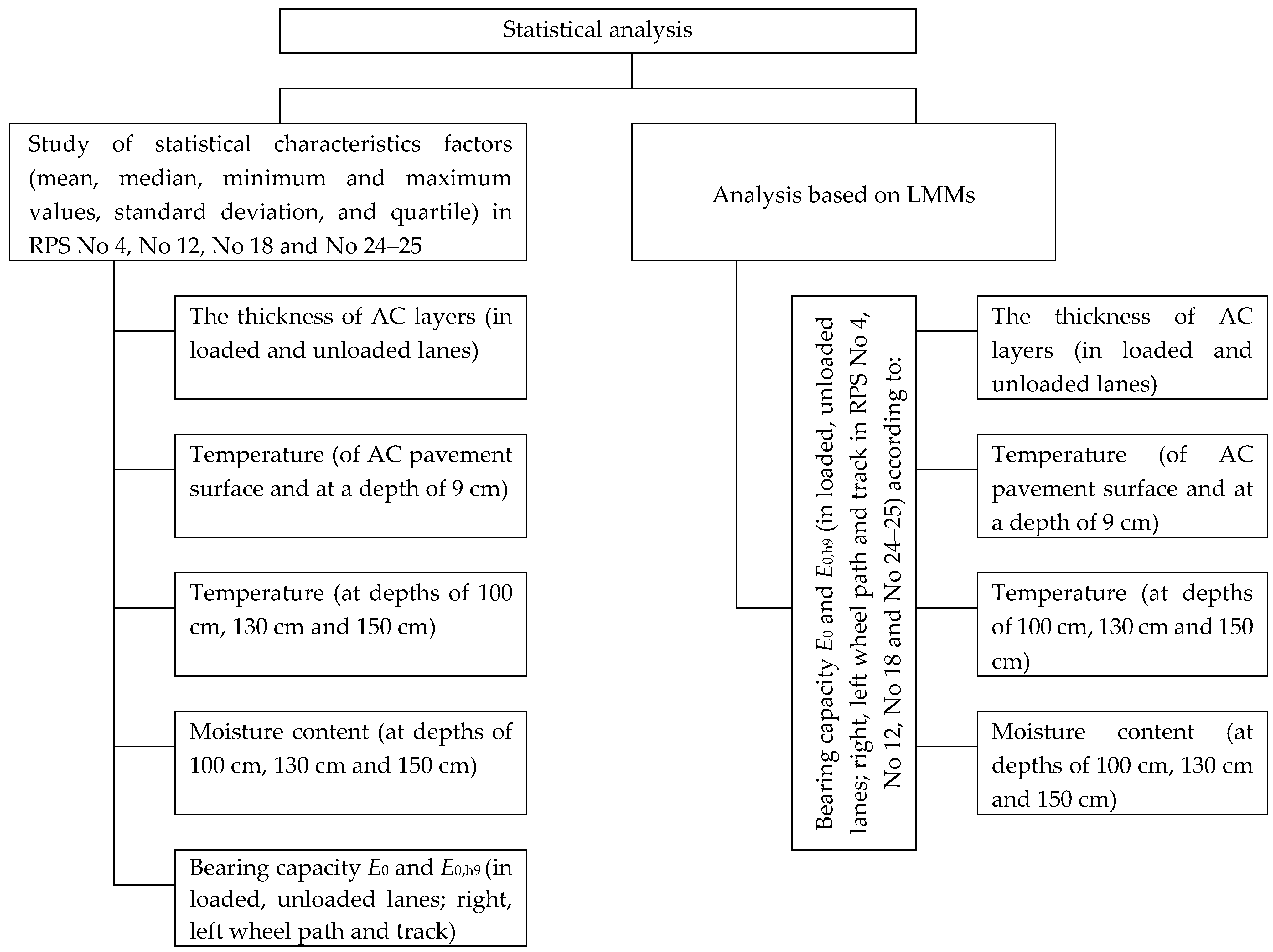
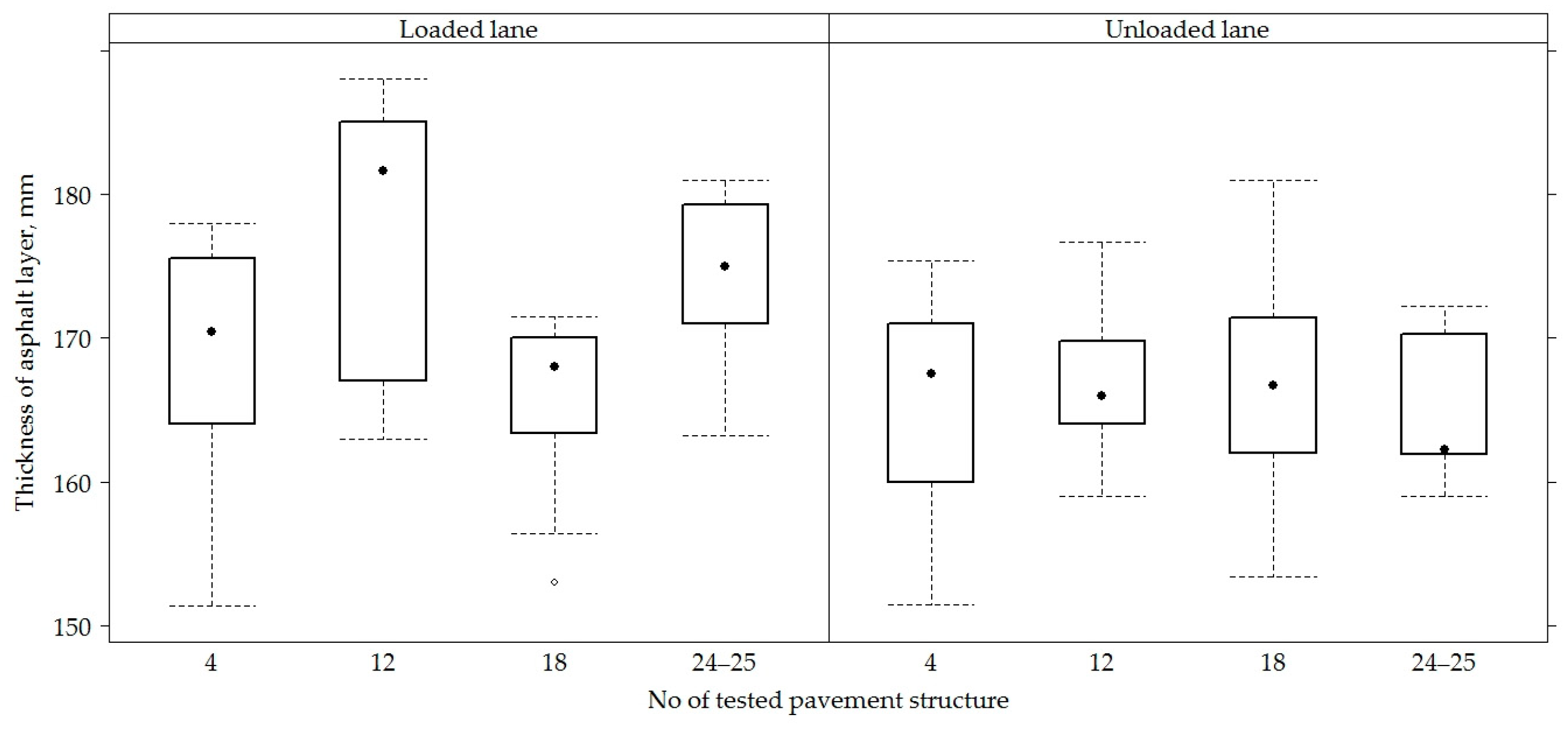
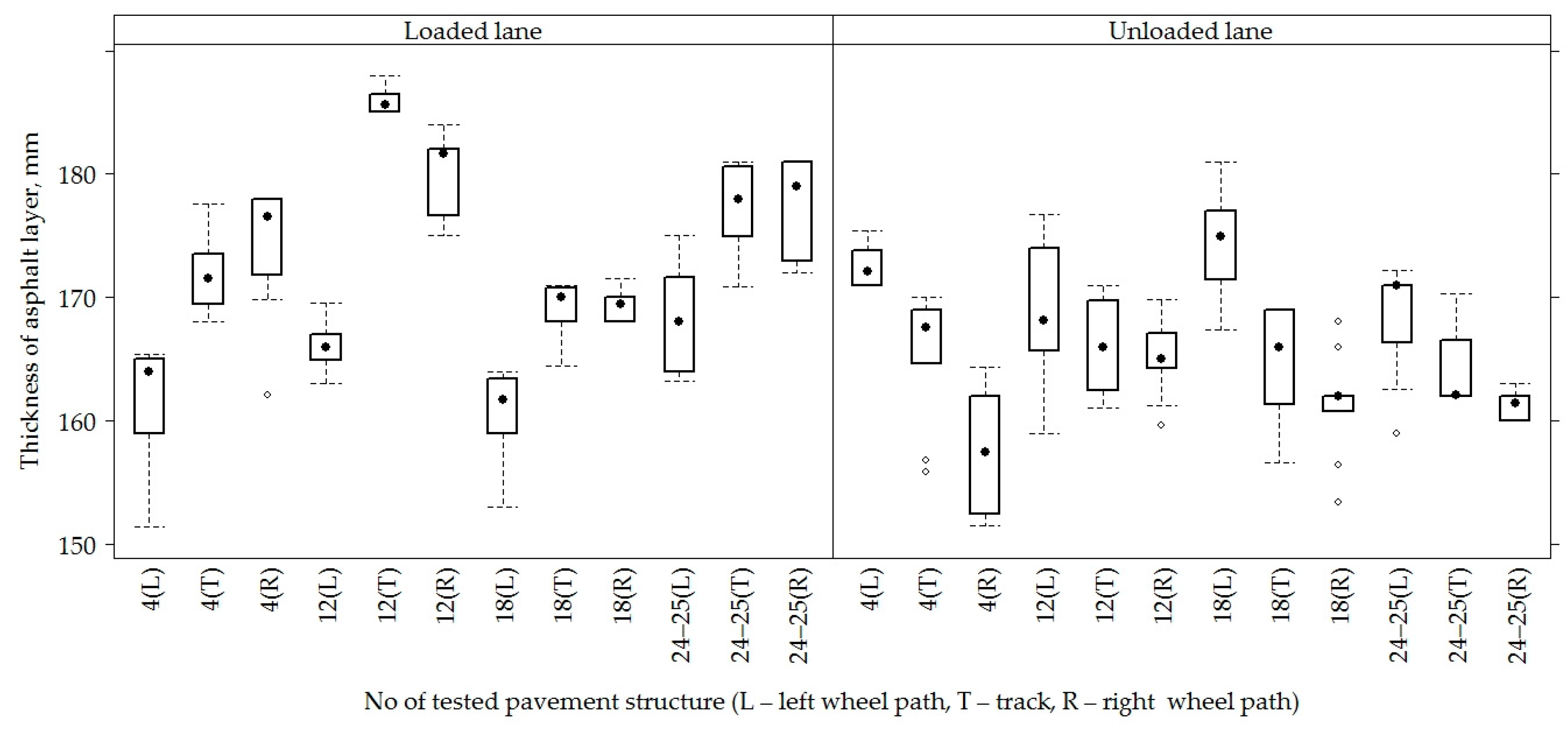

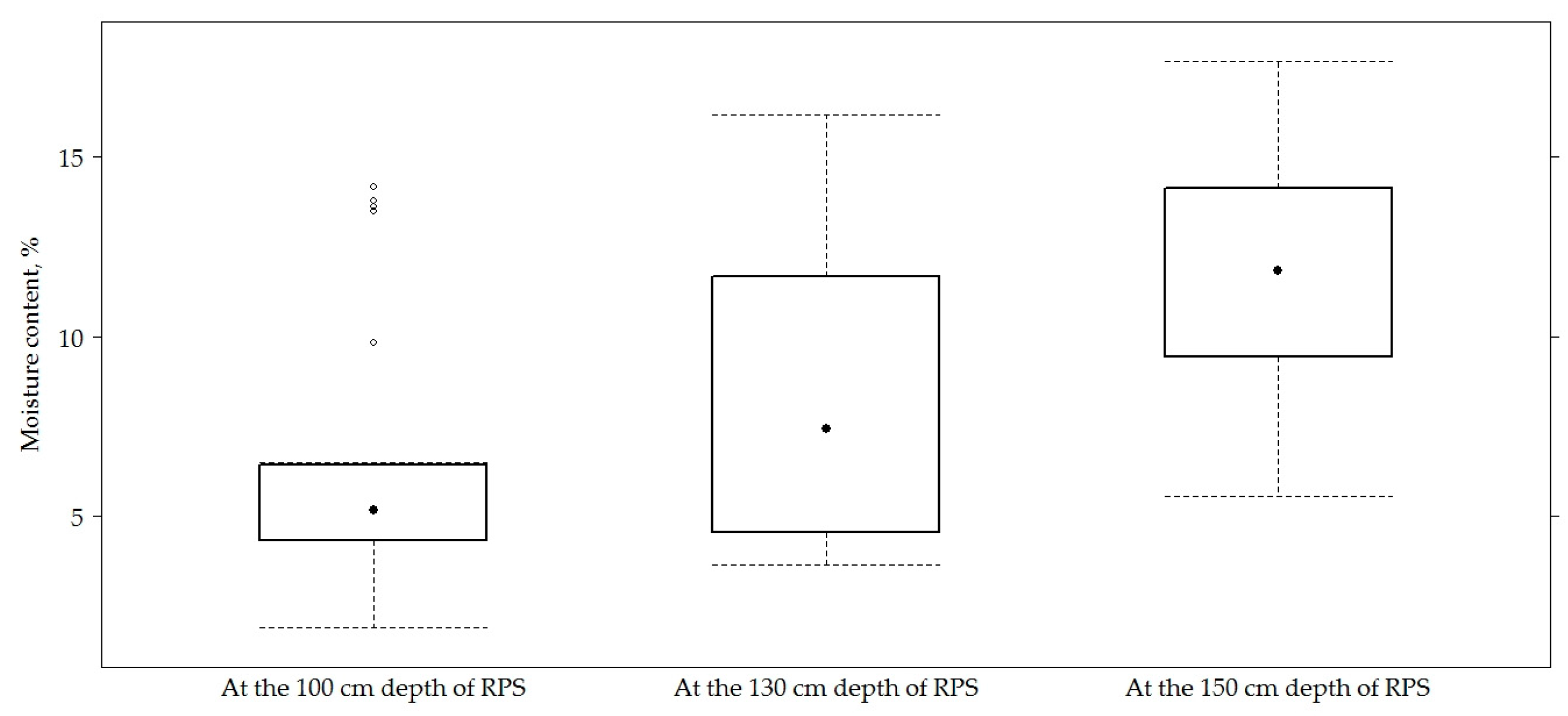
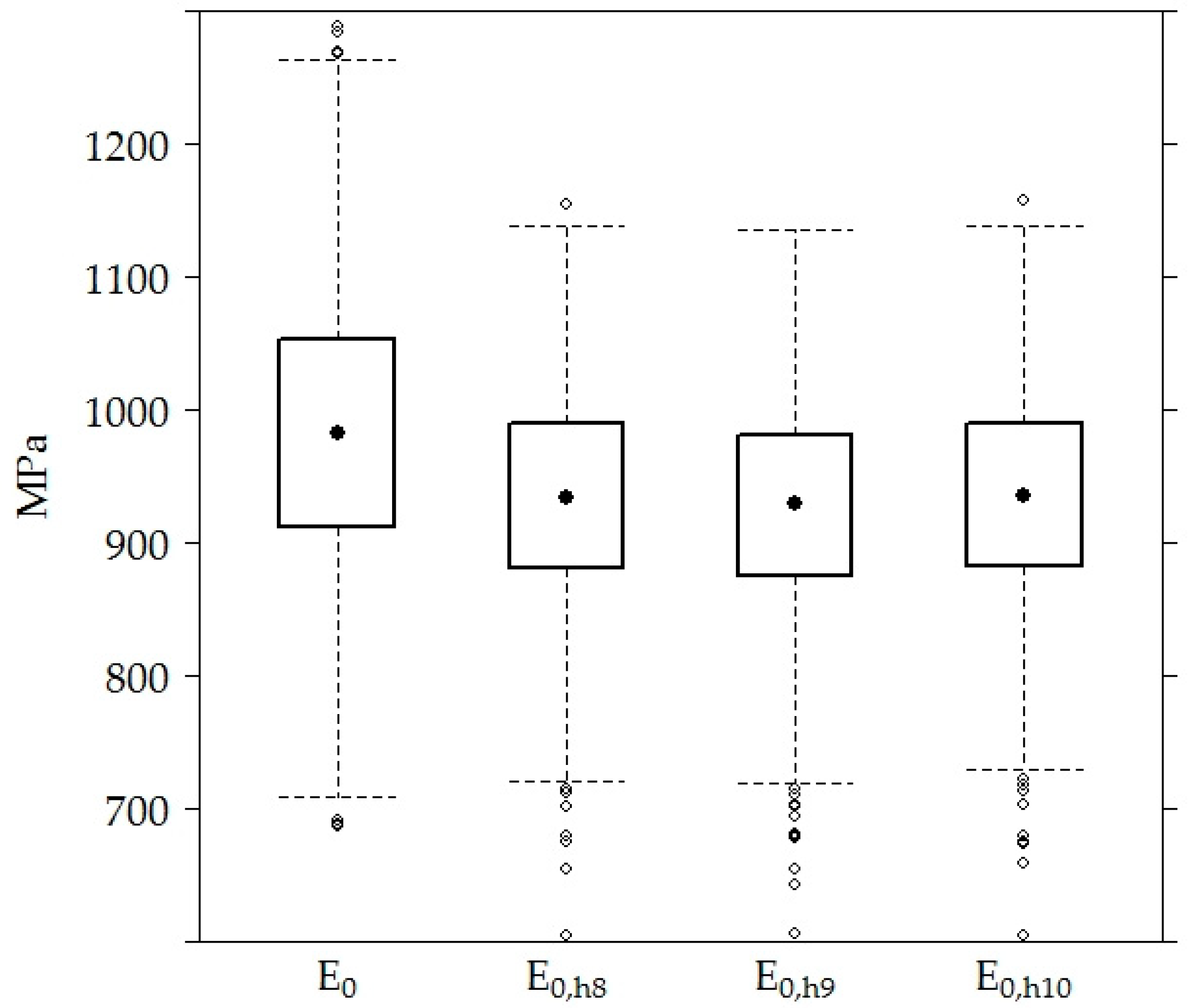
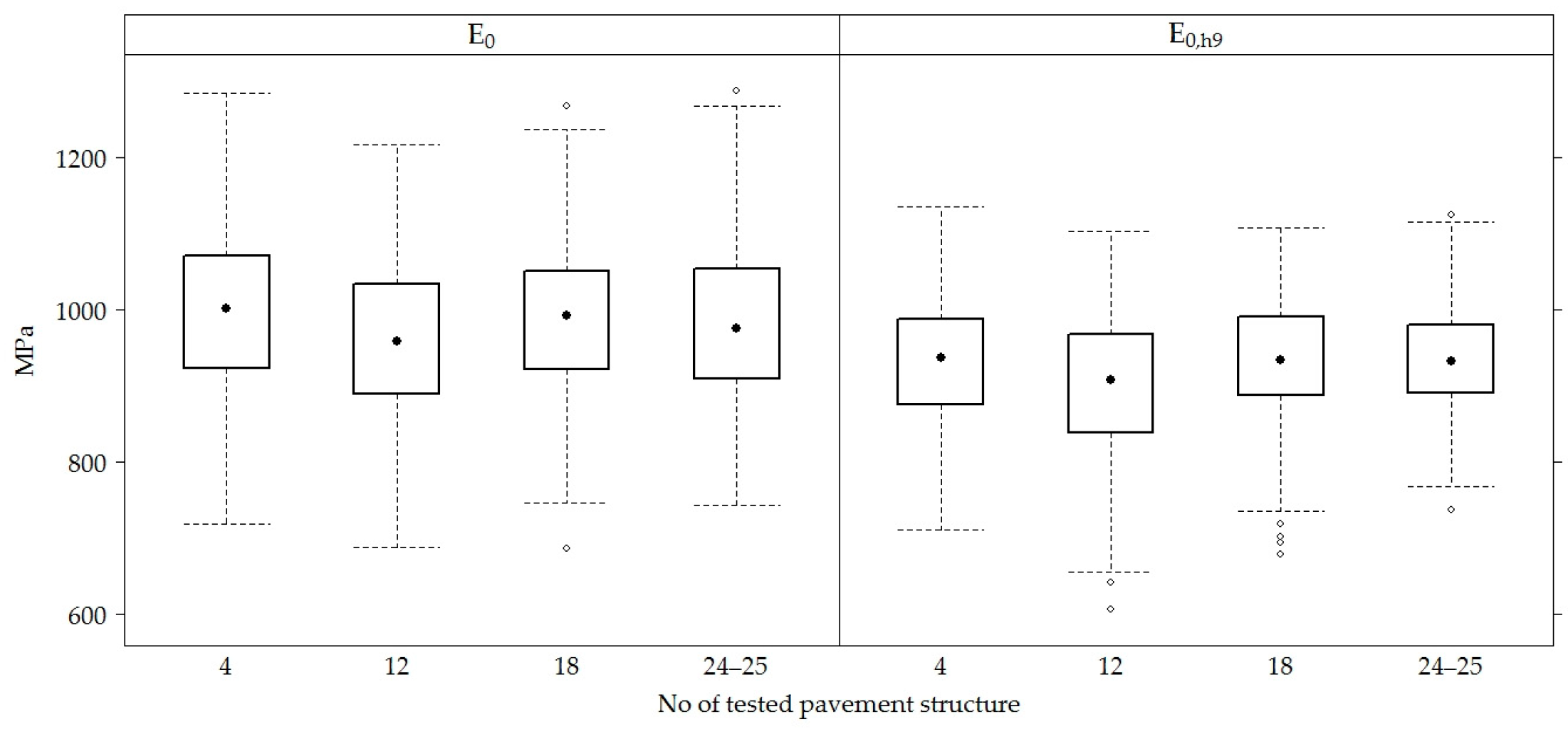
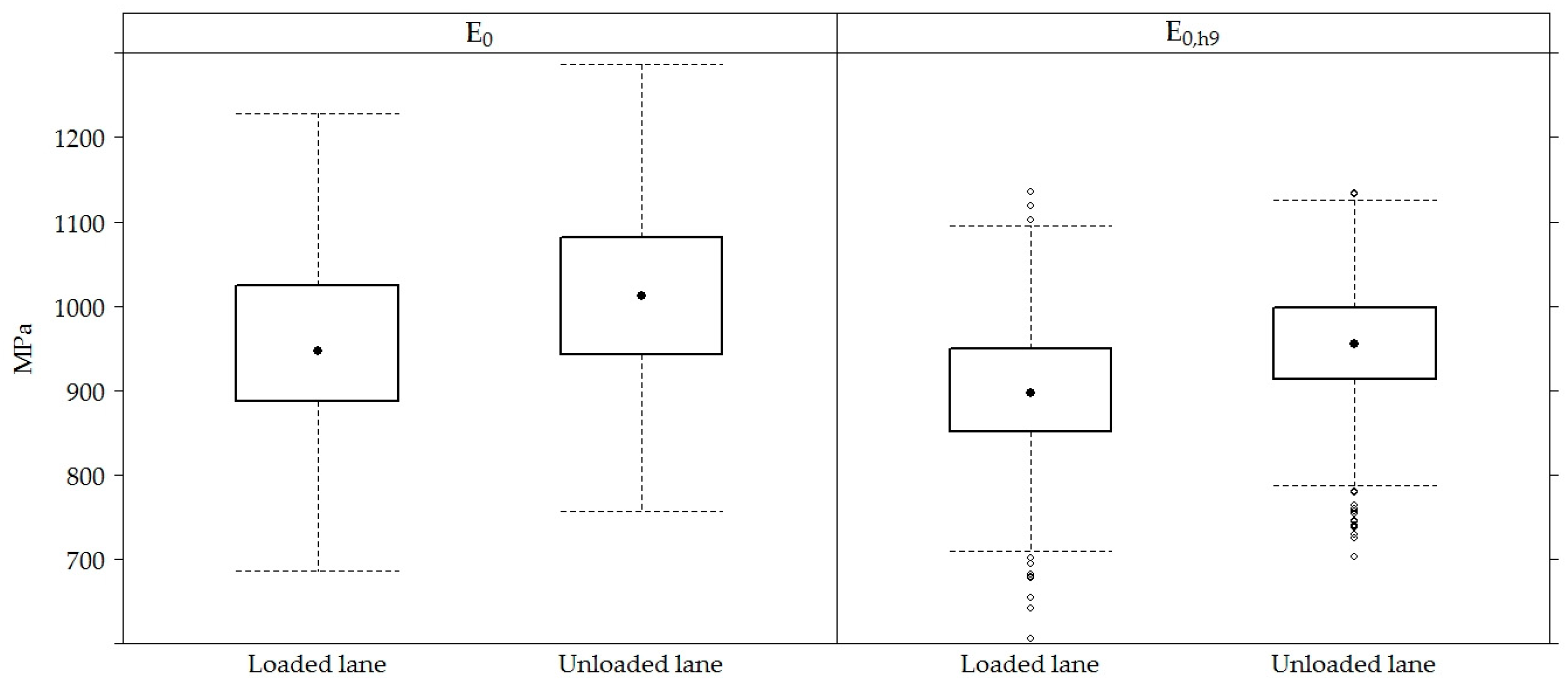
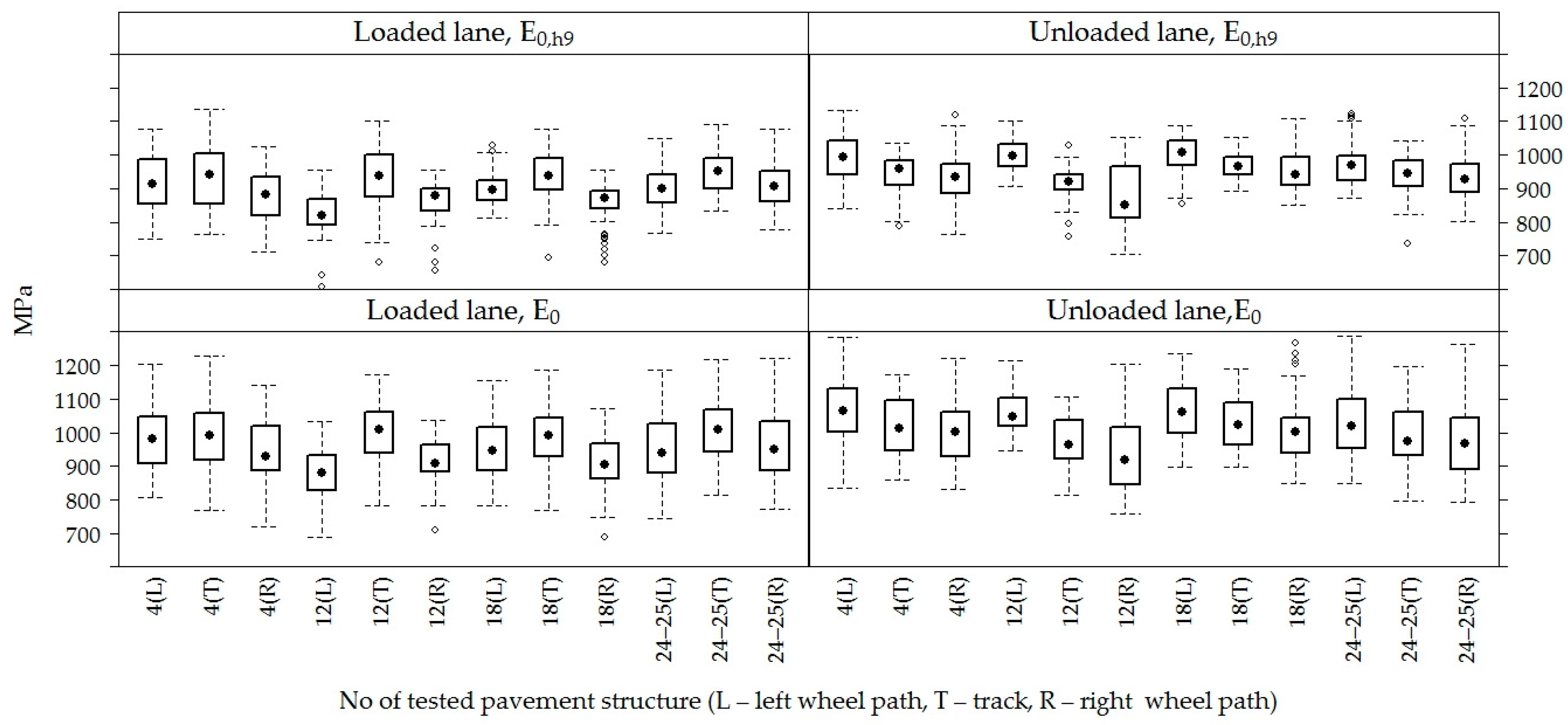
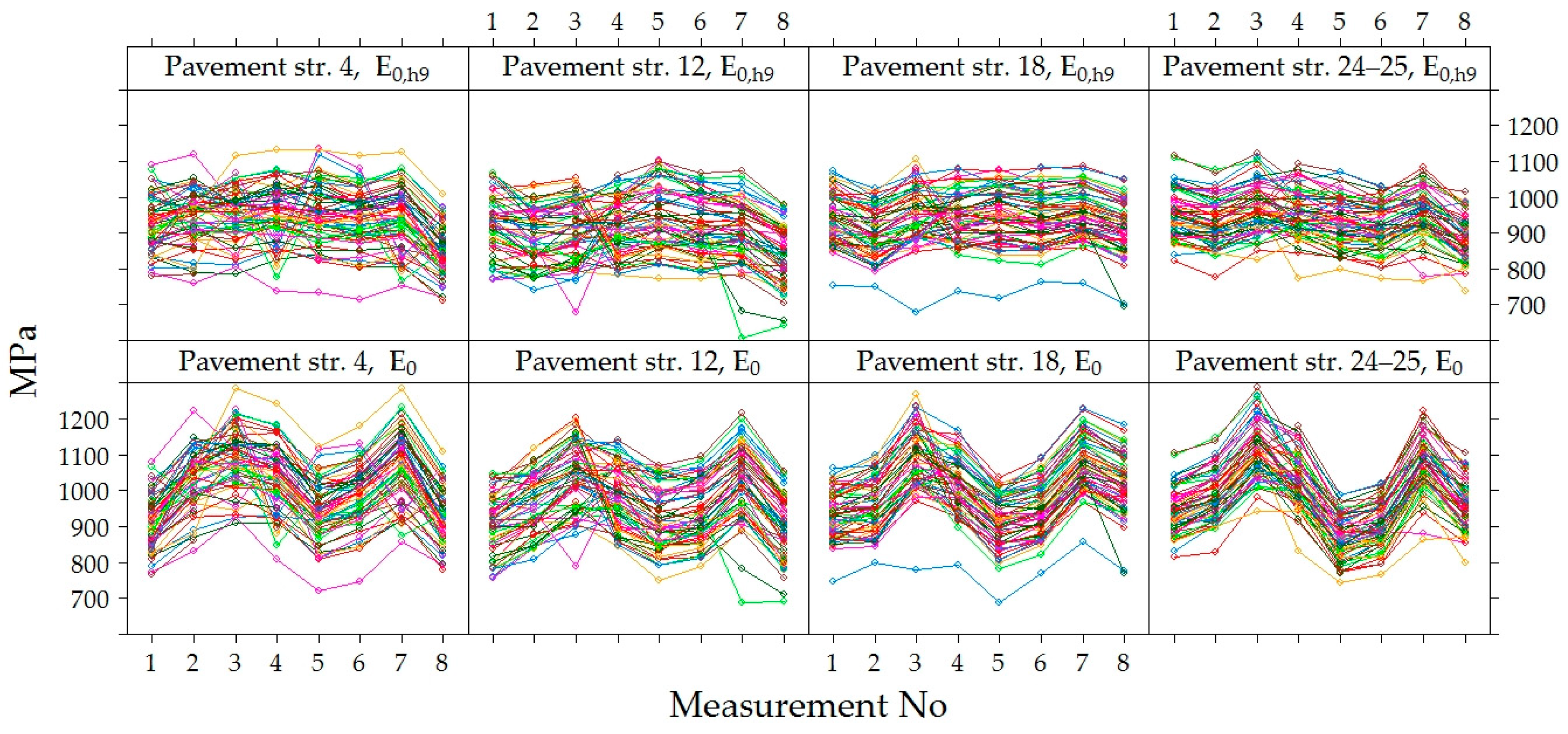
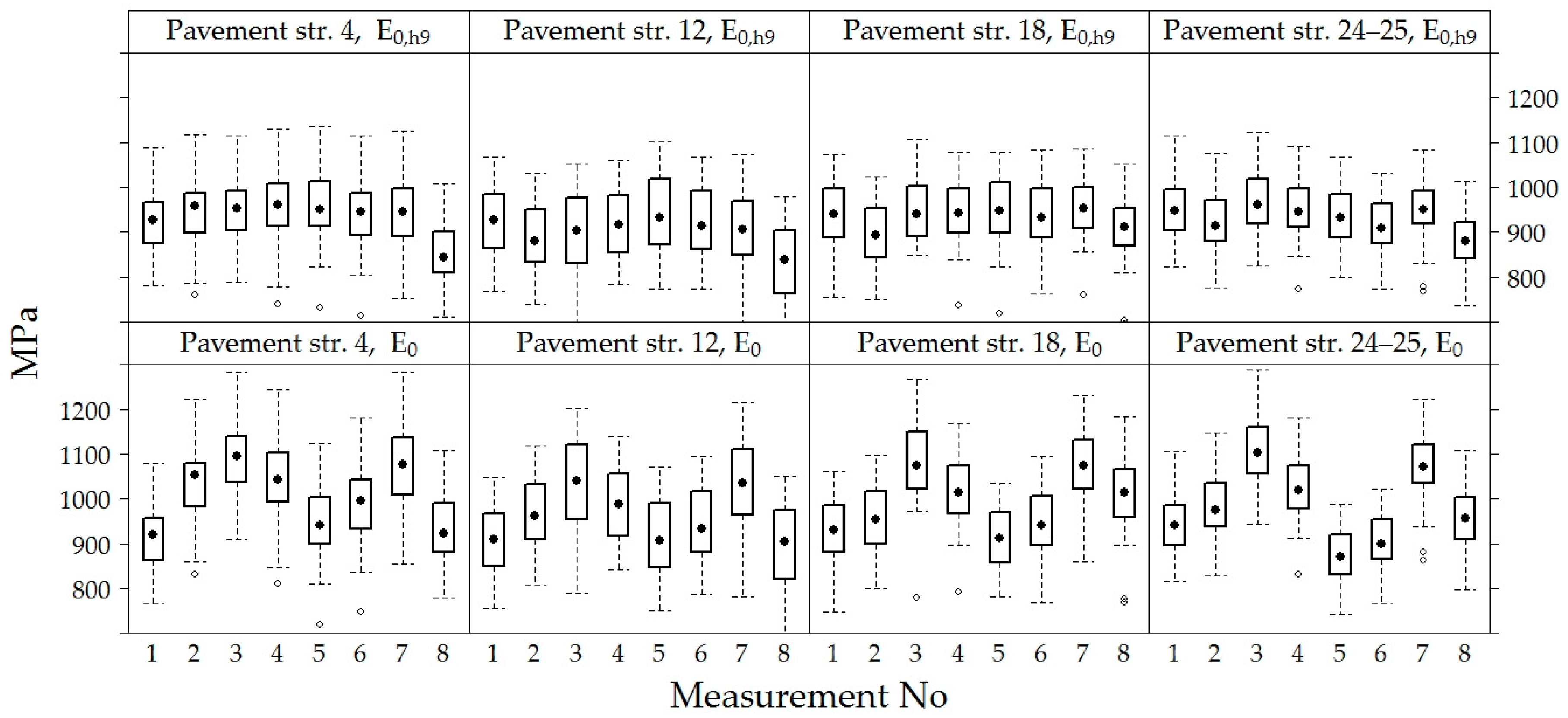

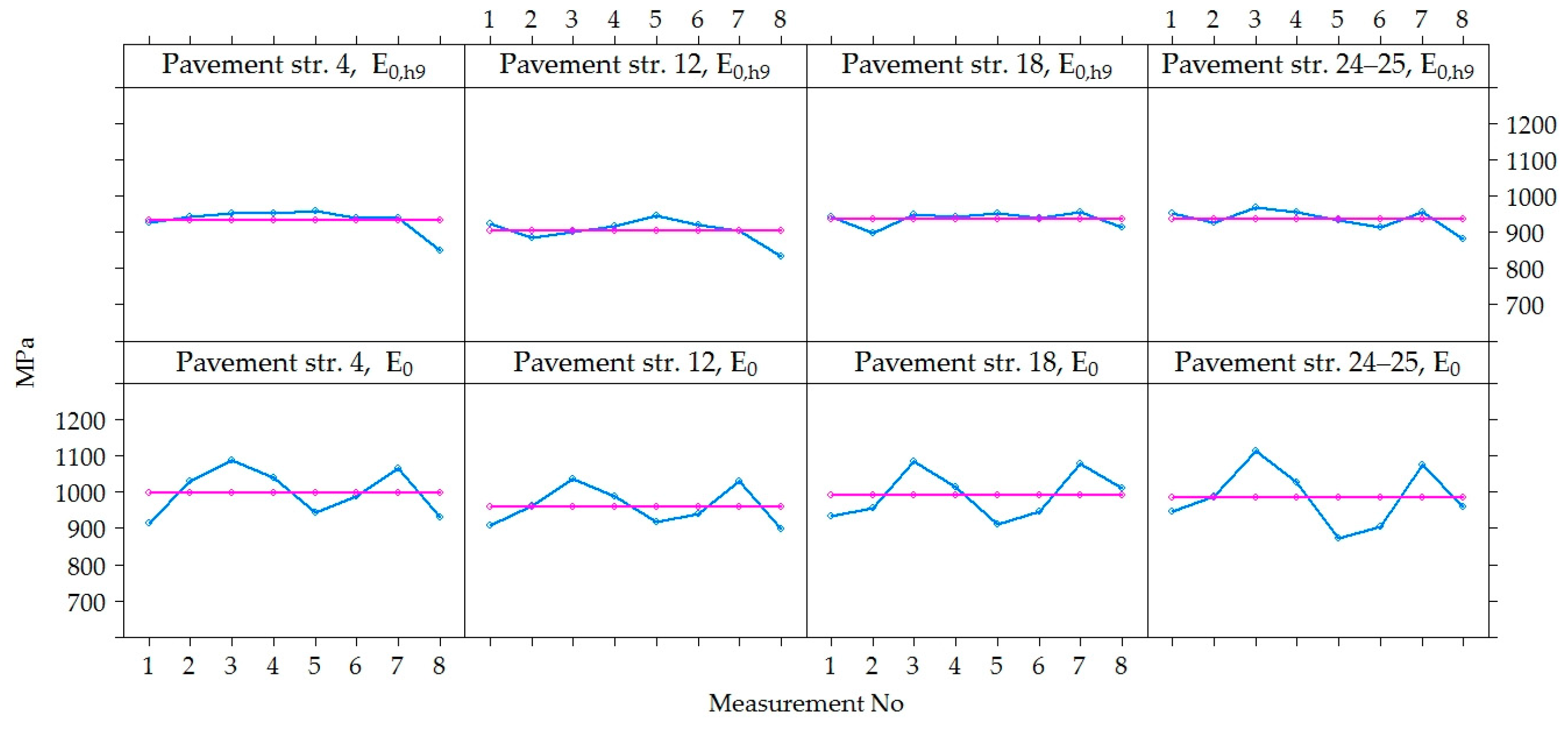
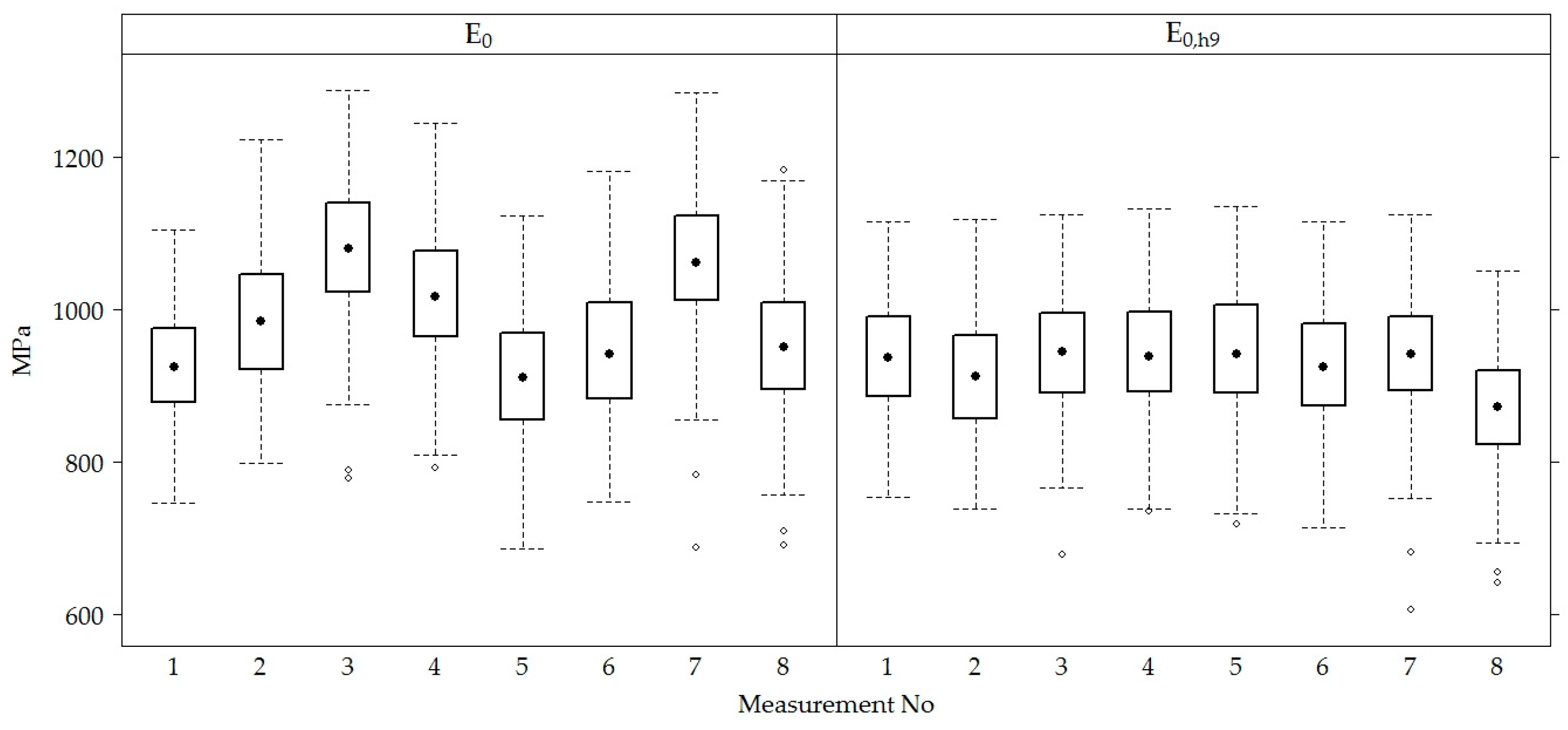
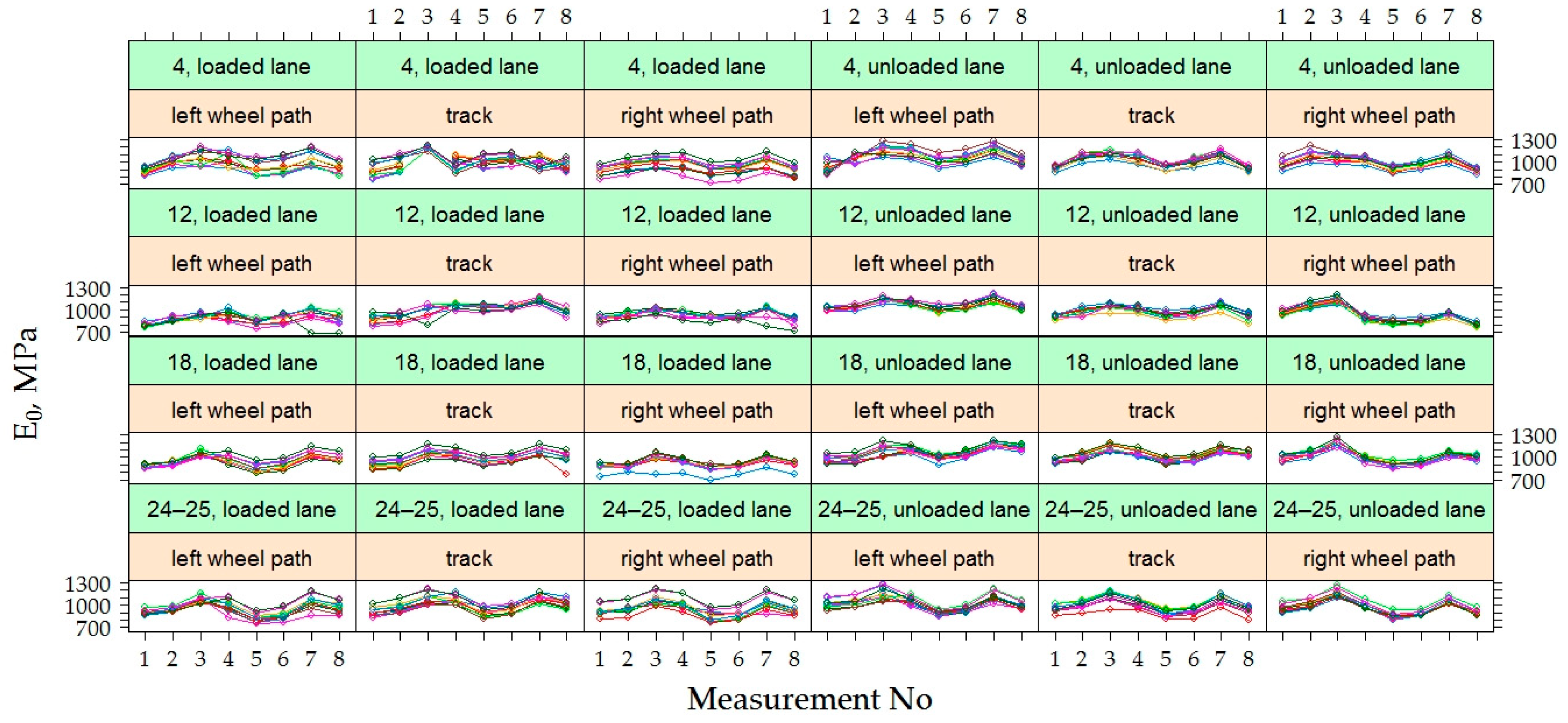
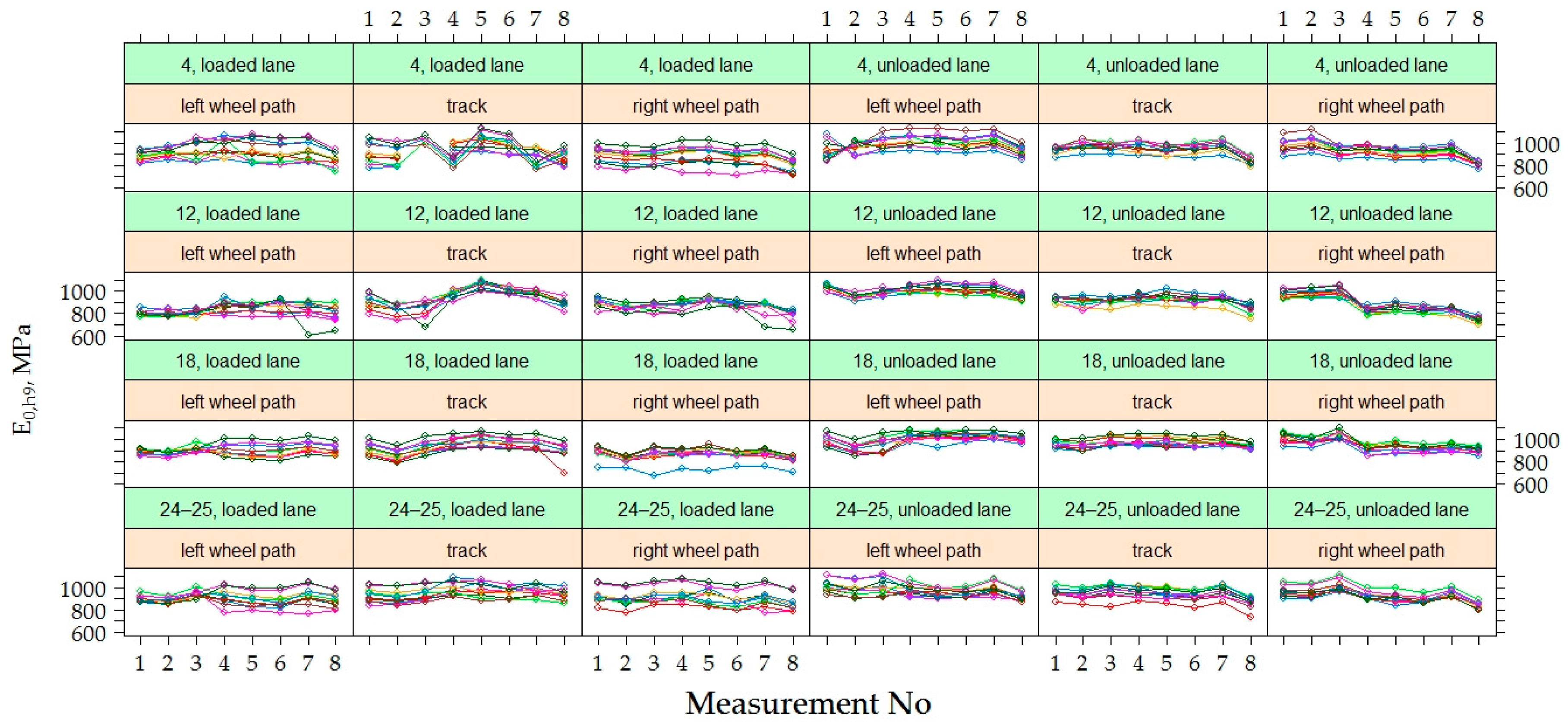
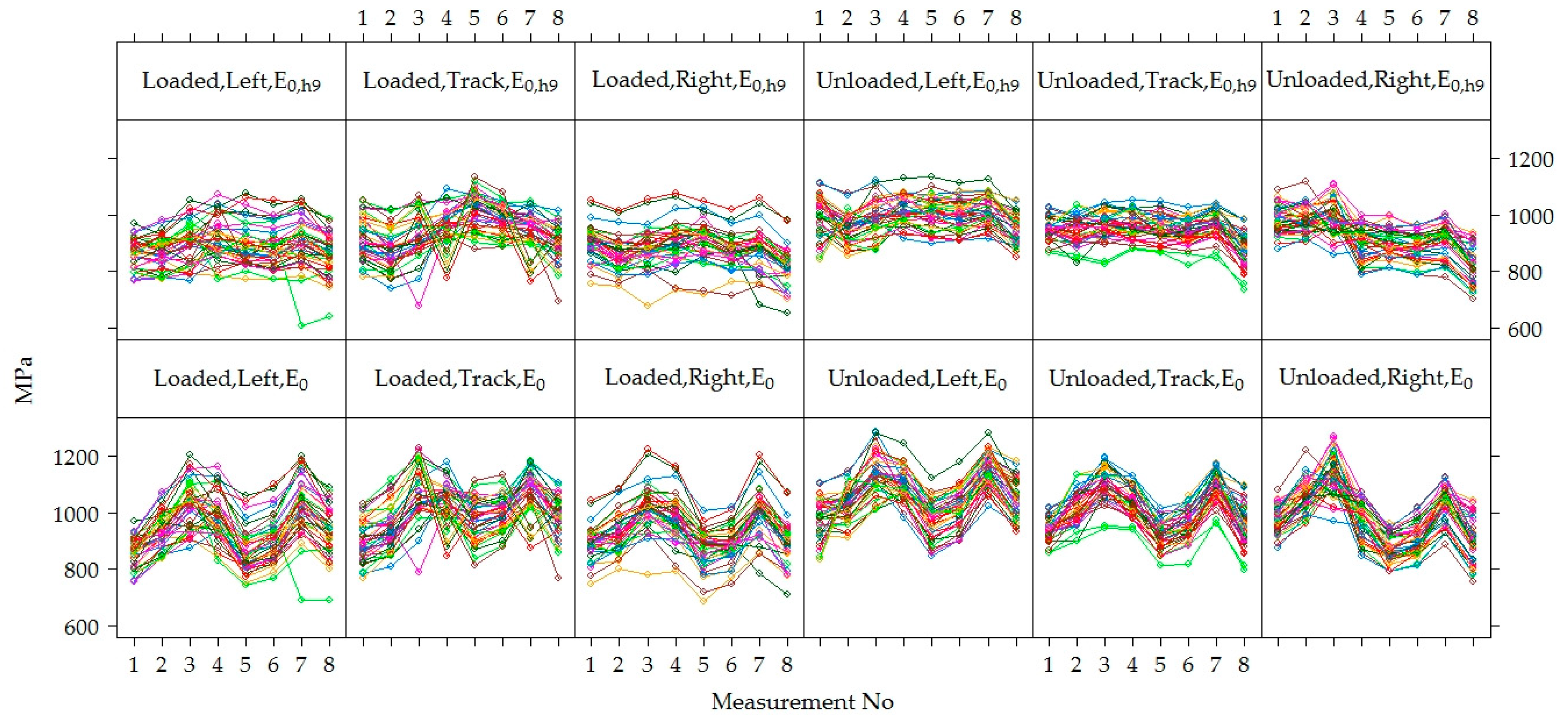


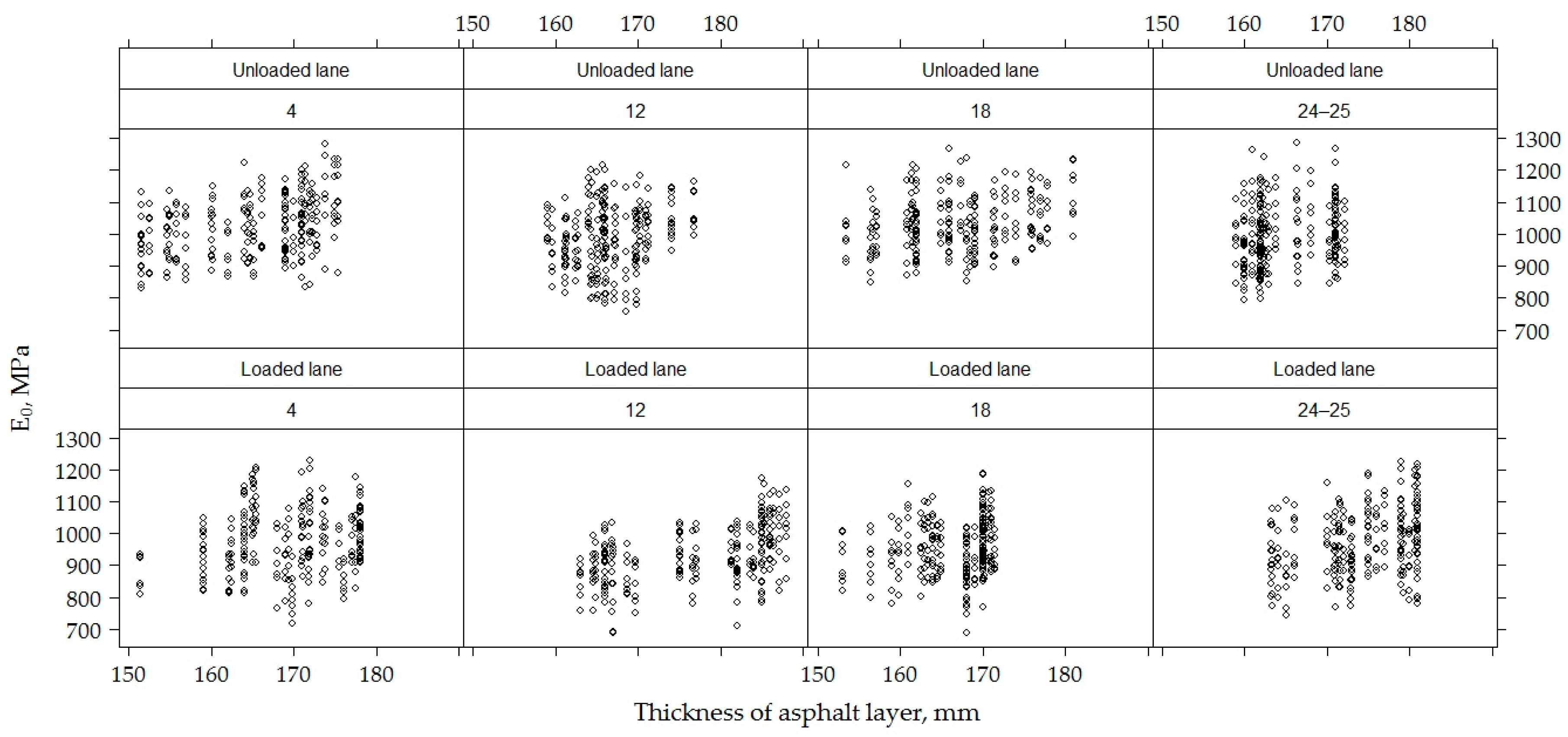
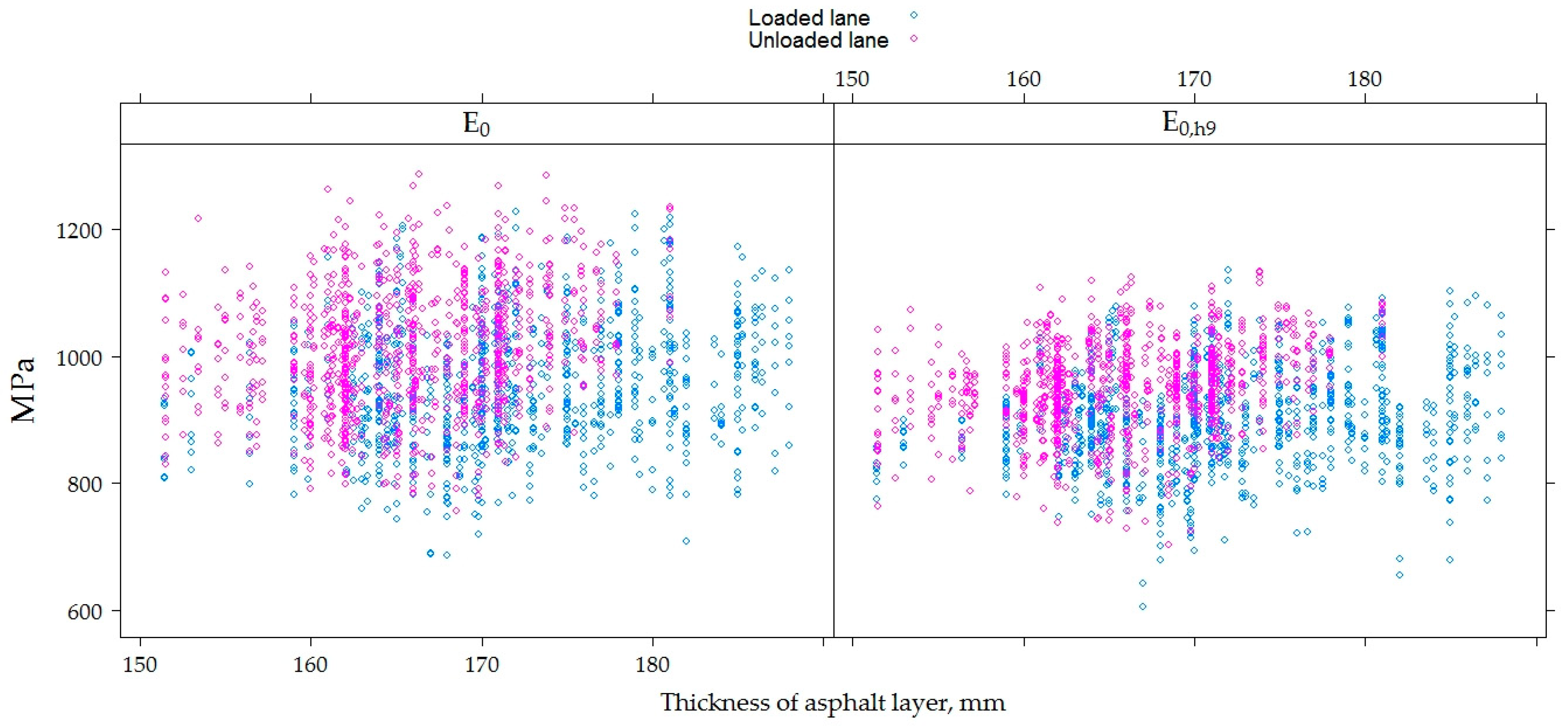
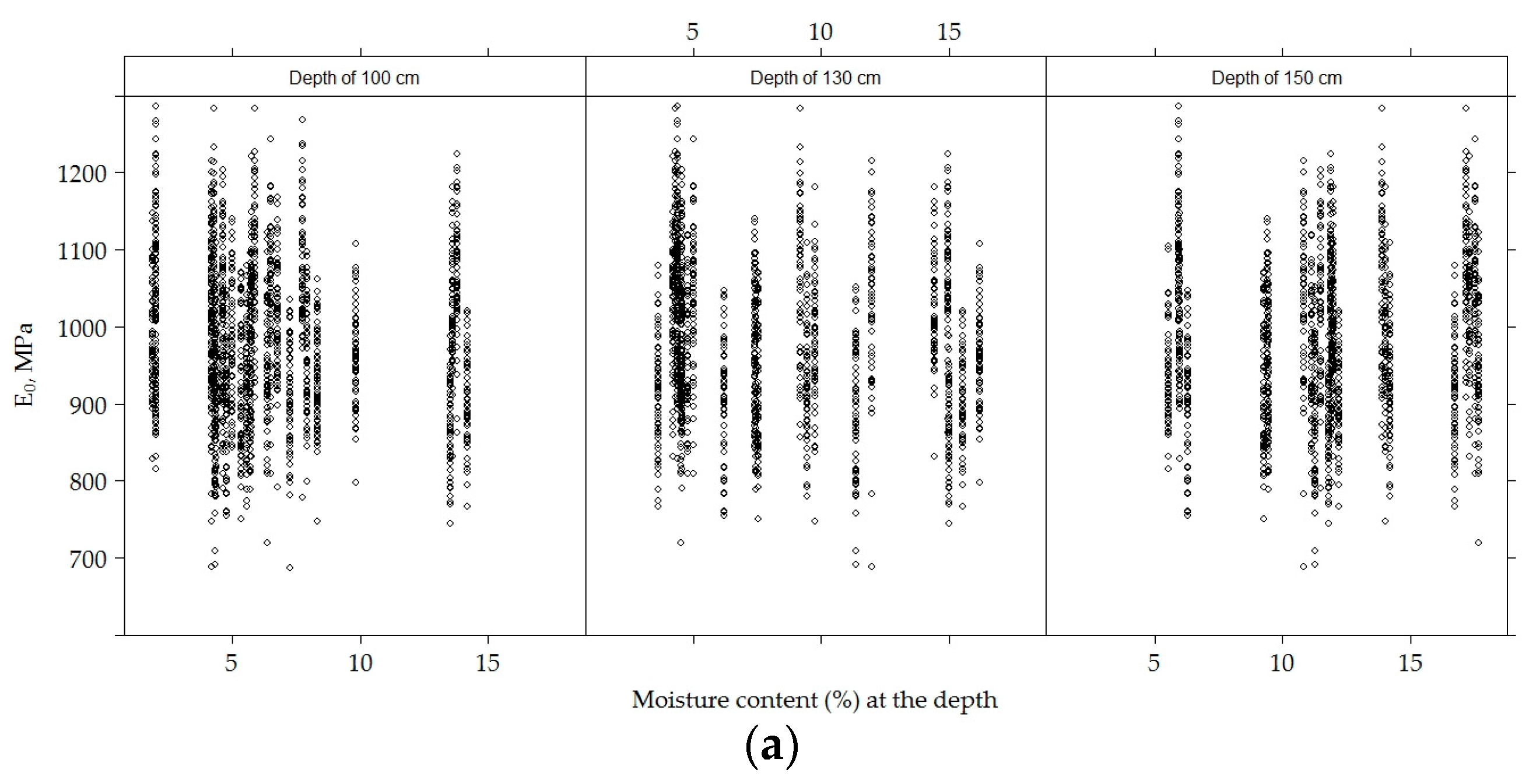

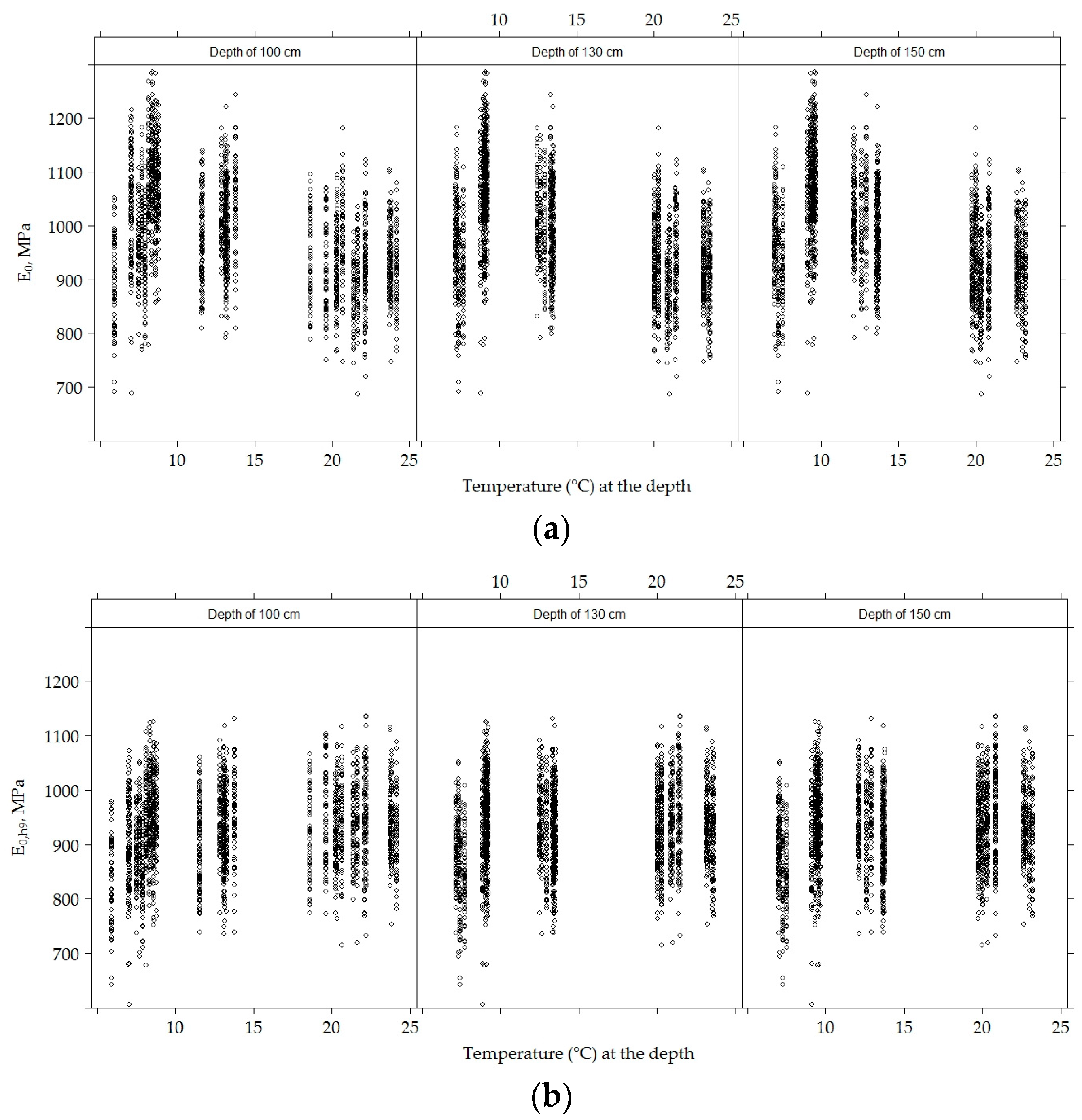
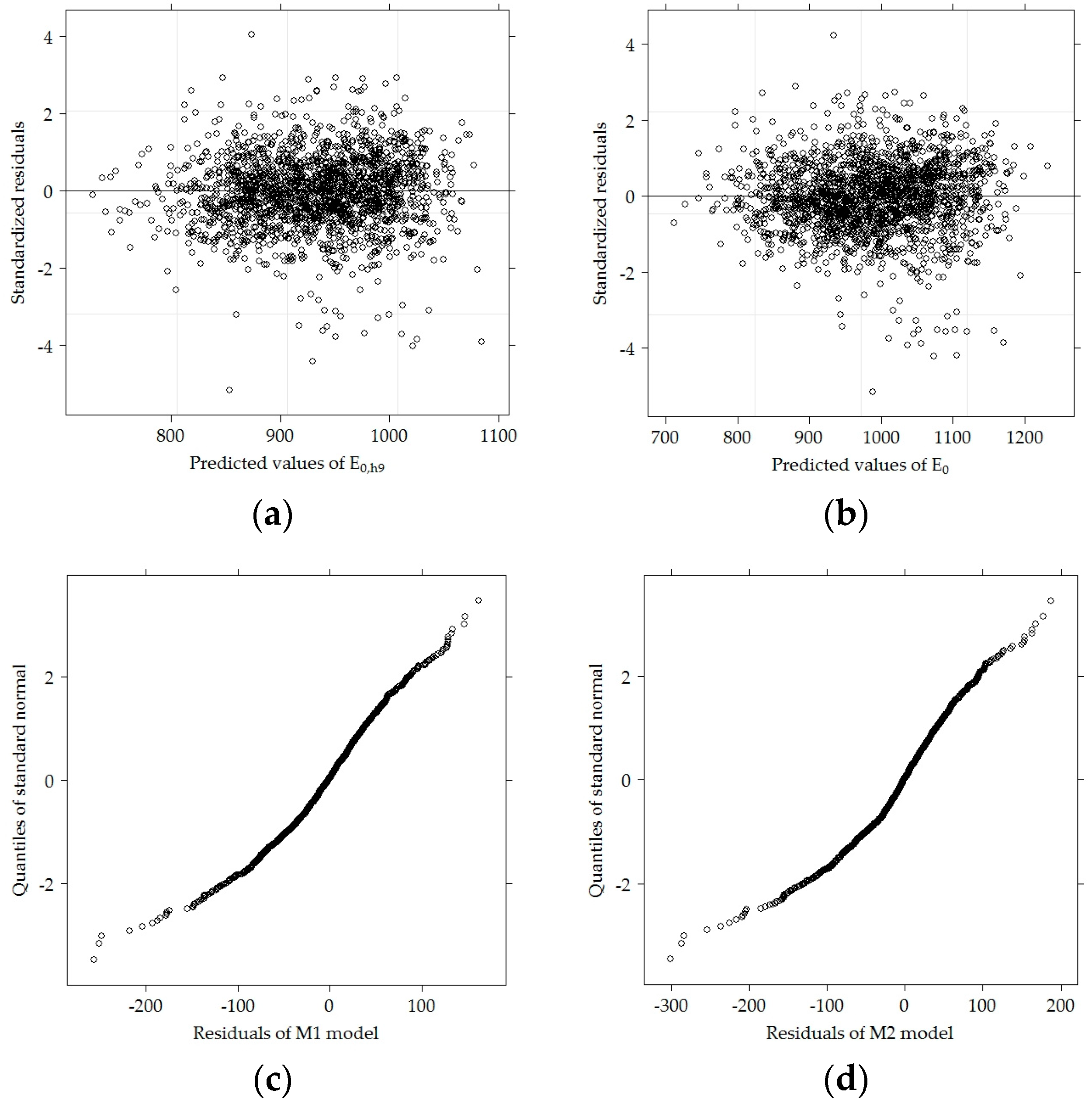
| No of the Road PS | Road PS | Soil of Subgrade (Continuous Measurements) | |
|---|---|---|---|
| Temperature | Temperature | Moisture Content | |
| No 4 | on the top; at a depth of 9 cm | at a depth of 100 cm; 130 cm; 150 cm | |
| No 12 | on the top at a depth of 8 cm; 9 cm; 10 cm | at a depth of 100 cm; 130 cm; 150 cm | |
| No 18 | on the top; at a depth of 8 cm; 9 cm; 10 cm | at a depth of 100 cm; 130 cm; 150 cm | no sensor |
| No 24–25 | on the top; at a depth of 9 cm | at a depth of 100 cm; 130 cm; 150 cm | |
| Measurement No | Date | ESAL100 | Average Air Temperature during Measurement Time, °C | Average Pavement Surface Temperature during Measurement Time, °C | Average Asphalt Concrete Layer Temperature at a Depth of 9 cm during Measurement Time, °C |
|---|---|---|---|---|---|
| 1 | 22.08.2013 | 484,000 | 22 | 20 | 21 |
| 2 | 10.10.2013 | 508,000 | 13 | 10 | 12 |
| 3 | 14–15.11.2013 | 537,000 | 5 | 3 | 5 |
| 4 | 07.05.2014 | 596,000 | 12 | 14 | 12 |
| 5 | 14.07.2014 | 621,000 | 25 | 31 | 24 |
| 6 | 16.09.2014 | 637,000 | 19 | 23 | 18 |
| 7 | 13.11.2014 | 654,000 | 7 | 7 | 6 |
| 8 | 22–23.04.2015 | 678,000 | 9 | 18 | 10 |
| E0 | E0,h9 | Temperature | Moisture Content | The Thickness of the Asphalt Layer | ||||||||
|---|---|---|---|---|---|---|---|---|---|---|---|---|
| At a Depth of 100 cm | At a Depth of 130 cm | At a Depth of 150 cm | On the Top of RPS (Measured Manually) | At a Depth of 9 cm of RPS (Measured Manually) | At a Depth of 100 cm | At a Depth of 130 cm | At a Depth of 150 cm | |||||
| E0 | 1.00 | 0.75 | −0.38 | −0.39 | −0.37 | −0.53 | −0.54 | −0.09 | −0.12 | 0.08 | 0.07 | |
| E0,h9 | 0.75 | 1.00 | 0.25 | 0.24 | 0.24 | 0.03 | 0.14 | 0.07 | −0.10 | 0.01 | 0.12 | |
| Temperature | At a depth of 100 cm | −0.38 | 0.25 | 1.00 | 0.99 | 0.99 | 0.59 | 0.89 | 0.09 | −0.17 | −0.03 | −0.03 |
| At a depth of 130 cm | −0.39 | 0.24 | 0.99 | 1.00 | 1.00 | 0.58 | 0.89 | 0.04 | −0.21 | −0.10 | 0 | |
| At a depth of 150 cm | −0.37 | 0.24 | 0.99 | 1.00 | 1.00 | 0.55 | 0.87 | 0.03 | −0.23 | −0.11 | 0 | |
| On the top of RPS (measured manually) | −0.53 | 0.03 | 0.59 | 0.58 | 0.55 | 1.00 | 0.84 | 0.38 | 0.38 | 0 | 0.03 | |
| At a depth of 9 cm of RPS (measured manually) | −0.54 | 0.14 | 0.89 | 0.89 | 0.87 | 0.84 | 1.00 | 0.23 | 0.07 | −0.12 | 0.03 | |
| Moisture content | At a depth of 100 cm | −0.09 | 0.07 | 0.09 | 0.04 | 0.03 | 0.38 | 0.23 | 1.00 | 0.76 | 0.26 | −0.02 |
| At a depth of 130 cm | −0.12 | −0.10 | −0.17 | −0.21 | −0.23 | 0.38 | 0.07 | 0.76 | 1.00 | −0.02 | 0.03 | |
| At a depth of 150 cm | 0.08 | 0.01 | −0.03 | −0.10 | −0.11 | 0 | −0.12 | 0.26 | −0.02 | 1.00 | −0.16 | |
| The thickness of the asphalt layer | 0.07 | 0.12 | −0.03 | 0 | 0 | 0.03 | 0.03 | −0.02 | 0.03 | −0.16 | 1.00 | |
| Dependent Variable | Explanatory Variables | ||
|---|---|---|---|
| Tested PS | Variables Related to the Features of Measured Points in the PS | Time-Varying Properties | |
| E0 or E0,h9 | Identification number of the tested PS (section) | Identification number of the point in the tested PS. Lane (left wheel path, track and right wheel path). Loading feature (Yes/No). The thickness of the AC layer. | Time (of repeated measurements). Temperature (°C) and moisture content (%) in the soil of the subgrade at a depth of 100 cm, 130 cm and 150 cm. Temperature (°C) on the top of the road PS. Temperature (°C) of the AC layer at a depth of 9 cm. |
| Model Parameters | Estimated Parameters | |||||
|---|---|---|---|---|---|---|
| M1 Model | M2 Model | |||||
| Estimate | Standard Error | p-Value | Value | Standard Error | p-Value | |
| β0 (intercept) | 1002.65 | 11.19 | <0.001 | 454.96 | 79.89 | <0.001 |
| β1 (time) | −17.27 | 1.76 | <0.001 | −18.72 | 1.99 | <0.001 |
| β2 (left wheel path) | −21.97 | 10.04 | 0.029 | −21.31 | 10.08 | 0.0356 |
| β3 (track) | −21.64 | 10.06 | 0.0324 | −32.13 | 10.14 | 0.0017 |
| β4 (loaded lane) | −88.45 | 8.21 | <0.001 | −115.11 | 8.71 | <0.001 |
| β5 (time × loaded lane) | 9.33 | 1.01 | <0.001 | 10.03 | 1.08 | <0.001 |
| β6 (time × left wheel path) | 14.16 | 1.24 | <0.001 | 14.99 | 1.32 | <0.001 |
| β7 (time × track) | 15.58 | 1.24 | <0.001 | 17.09 | 1.32 | <0.001 |
| β8 (temperature) | - | - | - | −8.41 | 0.17 | <0.001 |
| β9 (thickness of AC layer) | - | - | - | 4.37 | 0.48 | <0.001 |
| β10 (temperature of the AC layer at a depth of 9 cm × moisture content at a depth of 100 cm) | - | - | - | 0.027 | 0.03 | 0.391 |
| Standard deviation of random parameters and correlation (elements of matrix D) | σintercept among sections = 14.83 σtrend among sections = 2.57 corintercept and trend among sections = −0.516 σintercept among points in the section = 48.55 | σintercept among sections = 18.89 σtrend among sections = 3.30 corintercept and trend among sections = −0.428 σintercept among points in the section = 52.19 | ||||
© 2019 by the authors. Licensee MDPI, Basel, Switzerland. This article is an open access article distributed under the terms and conditions of the Creative Commons Attribution (CC BY) license (http://creativecommons.org/licenses/by/4.0/).
Share and Cite
Vaitkus, A.; Žalimienė, L.; Židanavičiūtė, J.; Žilionienė, D. Influence of Temperature and Moisture Content on Pavement Bearing Capacity with Improved Subgrade. Materials 2019, 12, 3826. https://doi.org/10.3390/ma12233826
Vaitkus A, Žalimienė L, Židanavičiūtė J, Žilionienė D. Influence of Temperature and Moisture Content on Pavement Bearing Capacity with Improved Subgrade. Materials. 2019; 12(23):3826. https://doi.org/10.3390/ma12233826
Chicago/Turabian StyleVaitkus, Audrius, Laura Žalimienė, Jurgita Židanavičiūtė, and Daiva Žilionienė. 2019. "Influence of Temperature and Moisture Content on Pavement Bearing Capacity with Improved Subgrade" Materials 12, no. 23: 3826. https://doi.org/10.3390/ma12233826
APA StyleVaitkus, A., Žalimienė, L., Židanavičiūtė, J., & Žilionienė, D. (2019). Influence of Temperature and Moisture Content on Pavement Bearing Capacity with Improved Subgrade. Materials, 12(23), 3826. https://doi.org/10.3390/ma12233826





